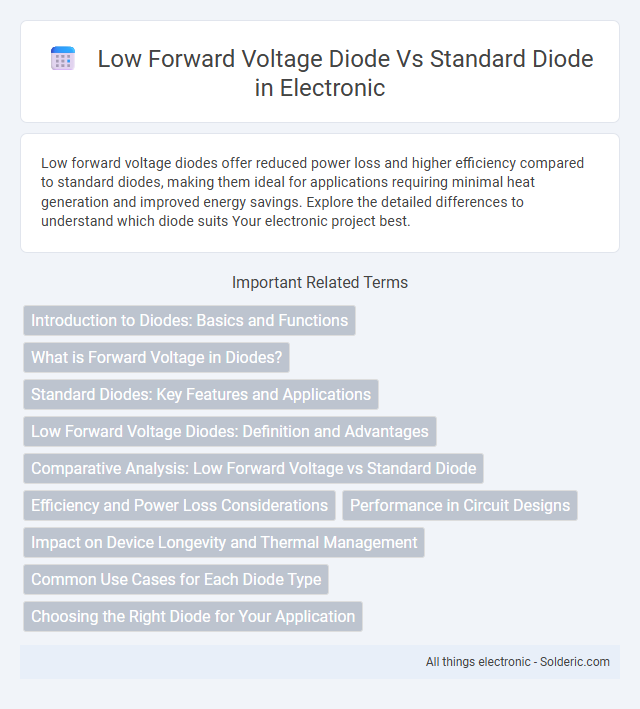Low forward voltage diodes offer reduced power loss and higher efficiency compared to standard diodes, making them ideal for applications requiring minimal heat generation and improved energy savings. Explore the detailed differences to understand which diode suits Your electronic project best.
Comparison Table
| Feature | Low Forward Voltage Diode | Standard Diode |
|---|---|---|
| Forward Voltage Drop (Vf) | Typically 0.2 - 0.4 V (Silicon Carbide, Schottky) | Typically 0.7 V (Silicon PN Junction) |
| Power Loss | Lower power dissipation due to reduced Vf | Higher power dissipation due to higher Vf |
| Switching Speed | Faster switching times | Slower due to minority carrier storage |
| Common Applications | Power supplies, high-efficiency circuits, switching regulators | General-purpose rectification, signal demodulation |
| Cost | Generally higher | Generally lower |
| Material | Silicon Carbide (SiC), Schottky Metal-Semiconductor | Silicon (Si) PN Junction |
Introduction to Diodes: Basics and Functions
Low forward voltage diodes operate with a reduced voltage drop, typically around 0.2 to 0.4 volts, compared to standard diodes which generally have a forward voltage drop near 0.7 volts for silicon types. This lower forward voltage enhances efficiency by minimizing power loss and heat generation in circuits such as rectifiers and power supplies. Understanding the fundamental operation of diodes, which allow current flow in one direction while blocking reverse current, is essential for selecting the appropriate diode type based on forward voltage requirements and application efficiency.
What is Forward Voltage in Diodes?
Forward voltage in diodes refers to the minimum voltage required for a diode to conduct current in the forward direction, typically ranging from 0.6V to 0.7V for standard silicon diodes. Low forward voltage diodes, often made from materials like Schottky or germanium, have a forward voltage as low as 0.2V to 0.4V, resulting in reduced power loss and improved efficiency in electronic circuits. Understanding your diode's forward voltage is crucial for optimizing performance, especially in power-sensitive applications.
Standard Diodes: Key Features and Applications
Standard diodes feature a typical forward voltage drop of approximately 0.7 volts for silicon types, which impacts their efficiency in power-sensitive circuits. These diodes are widely used for rectification in power supplies, signal demodulation, and voltage clamping due to their reliable switching and breakdown voltage characteristics. Their robustness and cost-effectiveness make them suitable for general-purpose applications where efficiency is less critical than performance consistency and durability.
Low Forward Voltage Diodes: Definition and Advantages
Low forward voltage diodes are semiconductor devices designed to minimize voltage drop during conduction, typically exhibiting forward voltages below 0.4 volts compared to standard diodes' 0.7 volts or higher. This reduced forward voltage improves energy efficiency by lowering power loss and heat generation, making them ideal for power-sensitive applications and enhancing overall circuit performance. Your choice of a low forward voltage diode can significantly optimize power consumption and thermal management in electronic designs.
Comparative Analysis: Low Forward Voltage vs Standard Diode
Low forward voltage diodes typically exhibit a forward voltage drop of approximately 0.3V to 0.4V, significantly lower than the 0.7V to 1.0V range found in standard silicon diodes, resulting in reduced power loss and improved efficiency in electronic circuits. The lower forward voltage improves battery life and decreases heat generation, making low forward voltage diodes ideal for power-sensitive applications such as portable devices and high-frequency switching circuits. When selecting a diode, consider your circuit's voltage and current requirements, as well as thermal management, to optimize performance and durability.
Efficiency and Power Loss Considerations
Low forward voltage diodes significantly improve efficiency by reducing the voltage drop across the diode during conduction, resulting in lower power dissipation compared to standard diodes. This reduced forward voltage directly translates to minimized power loss, which is essential in high-current applications where even small voltage drops can lead to substantial energy waste. Consequently, low forward voltage diodes enhance overall system performance by lowering heat generation and improving energy efficiency in power conversion and rectification processes.
Performance in Circuit Designs
Low forward voltage diodes exhibit significantly lower voltage drops, typically around 0.2 to 0.4 volts, compared to standard diodes which usually have forward voltages of 0.7 volts or higher, improving efficiency in power-sensitive circuit designs. This reduced forward voltage results in lower power dissipation and heat generation, enhancing reliability in high-current applications such as DC-DC converters and battery-powered devices. Designers prefer low forward voltage diodes for circuits requiring fast switching and minimal energy loss, optimizing overall system performance and longevity.
Impact on Device Longevity and Thermal Management
Low forward voltage diodes generate less heat during operation due to their reduced forward voltage drop, significantly improving device longevity by minimizing thermal stress on circuit components. Lower power dissipation enhances thermal management efficiency, reducing the need for extensive cooling solutions and lowering the risk of overheating-related failures. Standard diodes, with higher forward voltage drops, often contribute to increased junction temperatures, which can degrade performance and shorten the lifespan of electronic devices.
Common Use Cases for Each Diode Type
Low forward voltage diodes are commonly used in power-sensitive applications such as battery-powered devices, solar panels, and LED lighting, where minimizing voltage drop enhances energy efficiency and prolongs battery life. Standard diodes find frequent use in general-purpose rectification tasks, including power supplies, signal demodulation, and voltage protection circuits due to their robust performance and cost-effectiveness. Understanding Your circuit's efficiency requirements helps determine whether a low forward voltage diode or a standard diode is optimal for reliable operation.
Choosing the Right Diode for Your Application
Low forward voltage diodes minimize power loss and heat generation due to their reduced forward voltage drop, making them ideal for energy-efficient circuits and battery-powered devices. Standard diodes, with higher forward voltage, are suitable for general-purpose applications where cost and availability are more critical than efficiency. Selecting the right diode depends on balancing efficiency requirements, voltage ratings, current capacity, and thermal management specific to the application.
Low forward voltage diode vs Standard diode Infographic

 solderic.com
solderic.com